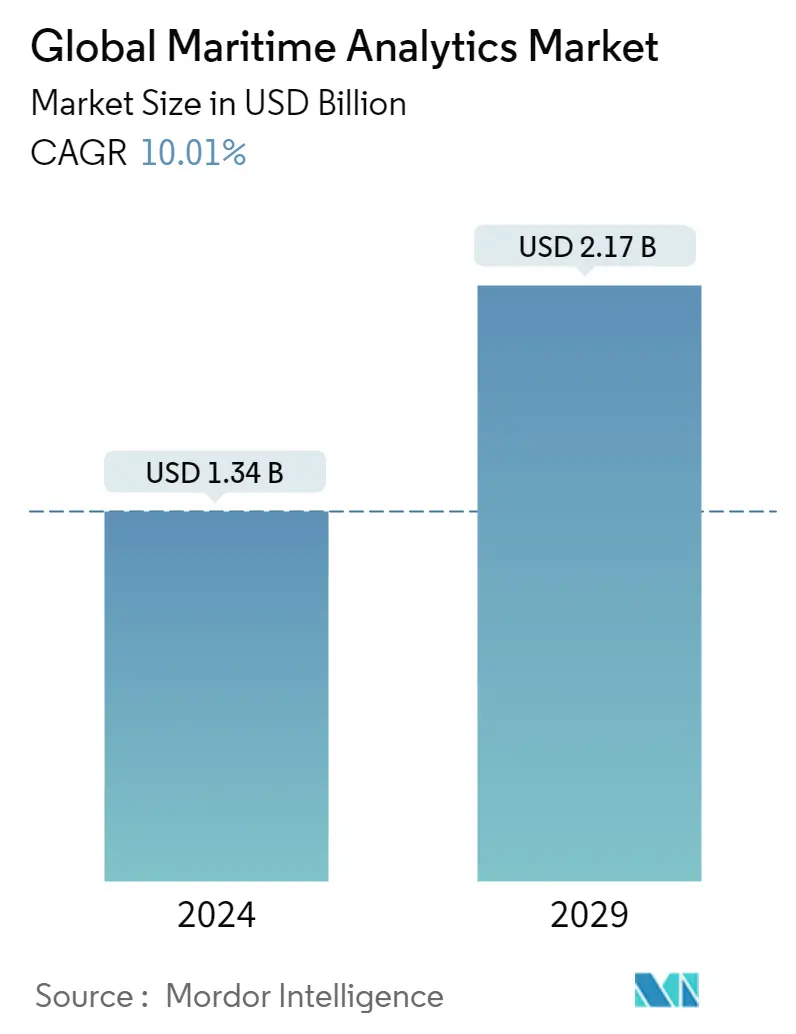Market Size of Global Maritime Analytics Industry

| Study Period | 2019 - 2029 |
| Market Size (2024) | USD 1.34 Billion |
| Market Size (2029) | USD 2.17 Billion |
| CAGR (2024 - 2029) | 10.01 % |
| Fastest Growing Market | Asia-Pacific |
| Largest Market | North America |
| Market Concentration | Medium |
Major Players
*Disclaimer: Major Players sorted in no particular order |
Maritime Analytics Market Analysis
The Global Maritime Analytics Market size is estimated at USD 1.34 billion in 2024, and is expected to reach USD 2.17 billion by 2029, growing at a CAGR of 10.01% during the forecast period (2024-2029).
With the rise of Big Data and the increasing need to make critical business decisions within a compressed timeframe, business intelligence, and analytics tools have gained a substantial market share in the past years. This trend is expected to increase steadily, along with the advancement of technology and rising investments, during the forecast period.
- The market size reflects the spending on maritime analytics solutions across studied end-users (government and commercial) and is computed realistically. Maritime Analytics is used in predictive maintenance, voyage operations, and fleet management applications.
- By enhancing overall shipping operations, enhancing ship safety, and safeguarding the environment, predictive analytics technologies have the potential to revolutionize the maritime sector. The significant degree of customization that these solutions provide, depending on the requirements of any port or shipping firm, is also anticipated to support demand over the projected period. Furthermore, This fleet management solution is crucial in saving costs and resource expenditure while ensuring that the fleet complies with the prevailing standards. Hence, these fleet management solutions are increasingly becoming essential to fleet operations. The overall efficiency of a business can be significantly enhanced by eliminating services that offer marginal value.
- The market is driven by the development of the latest analytical tools. Several BI tools on the market claim to be self-service. Modern self-service BI solutions mainly possess user-friendly graphical interfaces. With enough trial and error, users can often get the answers they want without calling IT for help or learning advanced database language skills. These systems can also handle millions and billions of rows drawn from multiple data sources: in-house databases, cloud storage, apps, Excel spreadsheets, and more. Also, non-technical users can generally choose and manipulate data sources and get them ready for analysis, speeding up time to insights and eliminating the IT bottleneck.
- However, the software licensing, data sources, and hours of research and assistance will affect how much the maritime analytic solutions cost. Companies who want to make data-driven decisions and are large enough to cover the cost and think about long-term growth and ROI stand to gain the most from maritime data analytics. However, knowing the price of maritime Analytics alone won't convince users to start spending money on the initiative. When it comes to data analytics, users must be fully aware of all possibilities. After all, there are other software options outside maritime analytics.
- The rising adoption of big data in the marine sector during the pandemic is thriving in the market. Big data analytics is likely to be one of the most significant growth factors for the shipping industry over the next decade. It stated that the shipping industry considers the development of automated processes and functions onboard vessels to be the biggest driver of efficiency in shipping.
Maritime Analytics Industry Segmentation
The growing analytics industry towards predictive and prescriptive analytics is penetrating a wide range of industrial applications. The scope of the study for maritime analytics market is limited to the respective applications of the type of solutions offered by the vendors for both government and commercial end-users globally.
The Global Maritime Analytics Market is segmented by Application (Predictive & Prescriptive Maintenance, Voyage Operations, Fleet Management), End-User (Government, Commercial), and Geography.
| By Application | |
| Predictive and Prescriptive Maintenance | |
| Voyage Operations | |
| Fleet Management | |
| Other Applications |
| By End-User | |
| Government | |
| Commercial |
| By Geography | |
| North America | |
| Europe | |
| Asia Pacific | |
| Rest of the World |
Global Maritime Analytics Market Size Summary
The maritime analytics market is experiencing significant growth, driven by the increasing adoption of big data and advanced analytics tools within the shipping industry. These tools are essential for enhancing operational efficiency, improving ship safety, and ensuring environmental sustainability. The market is characterized by a strong demand for predictive maintenance, voyage operations, and fleet management solutions, which are crucial for optimizing shipping operations and reducing costs. The development of user-friendly, self-service business intelligence tools is further propelling market expansion, as they enable non-technical users to analyze vast amounts of data without relying on IT support. This trend is expected to continue as technology advances and investments in maritime analytics increase.
Regionally, the Asia-Pacific area is anticipated to be the fastest-growing segment in the global maritime analytics market, fueled by the rising use of waterways for transportation and the growing popularity of digitalization. Countries like China and Japan are leading this growth, with significant investments in container shipping and digital maritime solutions. The market is moderately competitive, with major players focusing on reducing manufacturing costs and enhancing product offerings. Recent developments, such as partnerships and acquisitions, are further strengthening the market landscape, enabling companies to offer more sophisticated and integrated solutions to their customers.
Global Maritime Analytics Market Size - Table of Contents
-
1. MARKET INSIGHTS
-
1.1 Market Overview
-
1.2 Industry Attractiveness - Porter's Five Forces Analysis
-
1.2.1 Threat of New Entrants
-
1.2.2 Bargaining Power of Buyers
-
1.2.3 Bargaining Power of Suppliers
-
1.2.4 Threat of Substitute Products
-
1.2.5 Intensity of Competitive Rivalry
-
-
1.3 Industry Value Chain Analysis
-
1.4 Assessment of the Impact of COVID-19 on the Market
-
-
2. MARKET SEGMENTATION
-
2.1 By Application
-
2.1.1 Predictive and Prescriptive Maintenance
-
2.1.2 Voyage Operations
-
2.1.3 Fleet Management
-
2.1.4 Other Applications
-
-
2.2 By End-User
-
2.2.1 Government
-
2.2.2 Commercial
-
-
2.3 By Geography
-
2.3.1 North America
-
2.3.2 Europe
-
2.3.3 Asia Pacific
-
2.3.4 Rest of the World
-
-
Global Maritime Analytics Market Size FAQs
How big is the Global Maritime Analytics Market?
The Global Maritime Analytics Market size is expected to reach USD 1.34 billion in 2024 and grow at a CAGR of 10.01% to reach USD 2.17 billion by 2029.
What is the current Global Maritime Analytics Market size?
In 2024, the Global Maritime Analytics Market size is expected to reach USD 1.34 billion.

